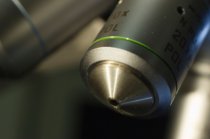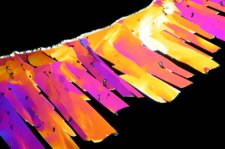Polarizing Microscope
Applications and Buyer's Guide in Light Microscopy

A petrographic or polarizing microscope is the ideal choice for birefringent materials, which have measurable refracting differences determined by observation direction.polarizing lens on microscope
These anisotropic objects and substances can be studied under a polarizer, which increases the quality of image contrast more so than other observation techniques, such as dark or brightfield illumination, DIC, fluorescence and phase contrast.
What is a polarizing or petrographic microscope?
A petrographic microscope is usually a modified compound microscope, although stereo microscopes can also be altered to achieve polarization.
This microscope differs from others because it contains the following components:
- A polarizer and analyzer
- A circular rotating stage
- Special plates or filters placed between the object and light path.
- Bertrand lens
A polarizer only allows certain light waves or vibrations to pass through it.
An analyzer, often a second polarizer located above the sample, determines the amount and direction of light that illuminates a sample.
At its most basic, the polarizer focuses the different wavelengths and vibrations of light onto a single plane.
The relationship of the polarizer and analyzer, in addition to possible filters added, determines the amount of light absorbed, reflected, refracted and/or transmitted through the microscope.
A polarizing microscope can employ transmitted and reflected light.
Transmitted light refers to the light diffused from below the specimen. This light is often passed through a condenser, which allows the viewer to see an enlarged contrasted image.
Reflected light, sometimes referred to as epi- or incidental light, is best suited for opaque samples, such as metals, alloys, composites and mineral oxides and sulfides.
Applications
Polarized microscopy is primarily used in the field of geology or petrography for the study of rocks and minerals, but has many other applications.

Additional science fields that benefit from polarization include medicine, chemistry, biology and metallurgy.
Featured at right: Citric acid crystals under polarized light.
Materials that can be examined under a polarized microscope include minerals, ceramics, polymers, wood, urea and numerous opaque and/or “thick” specimens.
Common substances/specimens, both of natural and synthetic fibers display birefringent properties and will "illuminate" between crossed polar filters.
Cellophane, crumpled up and stretched thin as well as sand are fascinating colorful subjects. The various components in several botanical and insect specimens display beautifully in polarized light. Fish scales are another good example.
Your kitchen cabinet and medicine cabinet comprise common chemical compounds ready to be used to prepare interesting slides. It's worth noting that these will typically need a certain degree of saturation before being placed on a slide for crystallization.
Polarization techniques allow researchers to obtain information on color absorption, structure, composition, light refraction and other properties of both isotropic and anisotropic substances.
Manufacturers and Models
Since their inception in the late 19th century, primary manufacturers of polarization microscopes have included:
- Nikon
- Olympus
- Zeiss
- Leitz
Despite their unique applications, petrographic microscopes are not as popular as they once were.
This is in part due to their primary geological applications as well as newer, dynamic microscopes that can be adapted for a wide range of study.
The best known polarizing microscopes on the market are made by Nikon and Olympus.
Nikon
Nikon is a global leader in optical devices, including cameras, telescopes and microscopes.
The company has made significant advances in the field of microscopy, including polarization techniques.
They currently offer three petrographic models in their Eclipse line, the LV100POL, 50iPOl and E200POL.
Each model has the following basic attributes:
- CF160 Infinity Optics System
- High-intensity 50w halogen light source that reduces power use and heat production, decreasing heat-induced focus drift
- Fly-eye lens
- Bertrand lens
- Universal nosepiece with accessories
- Rotating stage
- Conoscopic and orthoscopic capabilties
- Space-saving design
The Nikon Eclipse LV100POL is a mid-range choice, appropriate for professional and student laboratories; the 50iPOL is coined a “personal-type” microscope for it’s small size; and the E200POL is Nikon’s most advanced model.
This model is based on the Eclipse E200 compound biological microscope and is the most advanced polarizing microscope on the market.
Olympus
Olympus is another innovator of optical devices; the company manufactures cameras, binoculars, digital recorders for consumers as well as medical devices such as endoscopes and research products such as microscopes.
Many scientists enjoyed the Olympus BH-2 BHTP microscope as a polarizing lab staple.
This is an older model that’s wide-range of capabilities combined with its adaptability has prevented it from becoming obsolete.
At the time of this writing, Olympus only produces the student, polarizing model CX31-P.
This model is equipped with the following features:
- UIS2 Infinity system with Abbe condenser
- Conoscopic/orthoscopic attachments
- 360 degree rotating analyzer
- Binocular and trinocular observation tube
- 8 plates and condensers
- XY stage adapter
- Gout inspection kit
This microscope also has the standard polarizing items such as a Bertrand lens, plates and filters and rotating stage.
A polarizing microscope has a wide range of applications in fields such as geology, metallurgy and medicine.
The interaction between the polarizer and adapter allows researchers to obtain information about the color intensity, structure and composition of a birefringent sample.
They are especially ideal for anisotropic objects, such as minerals and rocks.
Almost any sample placed on a petrographic microscope stage can be explored in amazing depth and detail.
Explore MicroscopeMaster's recommendations of AmScope polarizing microscopes.
Read about: AmScope 40X-800X Polarizing Metallurgical Microscope with Top and Bottom Lights and 16MP Camera
A trusted company manufacturing sturdy microscopes at varying price points.
For further information about imaging techniques available, read about other microscopy imaging techniques here.
Return from Polarizing Microscope to Compound Light Microscope
Return from Polarizing Microscope to Best Microscope Home
Find out how to advertise on MicroscopeMaster!




